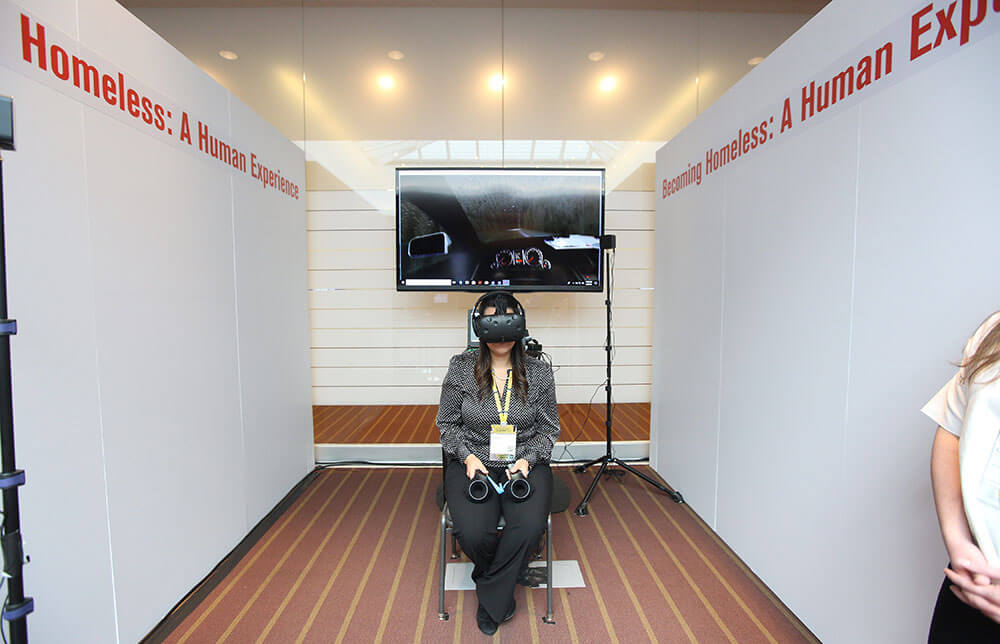
A Convening Leaders 2019 participant experiences homelessness via VR at the 1000 Cut Journey activation. (Every Angle Photography)
In a hallway at Pittsburgh’s David L. Lawrence Convention Center during PCMA’s Convening Leaders 2019 in January, you could take a deep dive into the ocean off the coast of Italy, find yourself suddenly homeless and forced to sleep on public transportation, or experience what it’s like to grow up as a black male. All you had to do was strap on a VR headset at the Virtual Reality Empathy Experience, sponsored by IMEX.
The ocean and homelessness experiences were designed by researchers at Stanford University, and the black male’s experience, called “The Thousand Cut Journey,” was a collaborative initiative between Stanford and Columbia University. The project gave Convening Leaders participants a chance to experience the power of VR for themselves and to evaluate its potential use for their own events. They were also given the option to provide ongoing feedback about their experience, becoming part of the schools’ body of research on how immersive VR experiences can foster empathy in participants and create a deeper understanding of the complexities and nuances surrounding social issues like sustainability, homelessness, and racism.
The ocean experience explores whether the technology is an effective mode to teach marine science and in turn encourage sustainable behavior among participants, said Tobin Asher, associate director of global partnerships at Stanford’s Virtual Human Interaction Lab. In the homeless experience, Stanford researchers have done longitudinal studies with participants in their lab to see if those who went through the VR experience felt empathy for homeless people for a period of time that extended beyond their initial experience.
The Thousand Cut Journey, which is led by Columbia University’s associate professor Courtney Cogburn, MSW, Ph.D., and funded by the Brown Institute for Media Innovation, “is really about going beyond the intellectual,” Asher said. “It’s about going beyond just feeling bad about [racism] but really starting to get a different sense of actually experiencing something that is outside of what many people, in our population — privileged, white people — experience.”
How Do You Measure Empathy?
The Virtual Human Interaction Lab has tended to focus on VR’s pro-social uses, Asher said, exploring how the technology may be used to positively impact society. Its ability to create empathy is measured by participant behavior. For example, those who went through the VR homelessness experience indicated that they would be more willing to support tax increases for affordable housing than before their experience, and they were significantly more likely to support those efforts than those who did not go through the VR experience, he said.
The researchers circle back with the participants several months later to see if those feelings persist. “What we find is while there’s no longer necessarily a difference in attitude of empathy,” Asher said, acknowledging that it would be difficult to maintain the same level of emotion months after the experience, there has been “a humanizing effect. So for people who have gone through the VR condition, there’s less deterioration over time of how people feel in terms of people who are homeless,” he said. “There’s more of a feeling of, ‘We’re all human. We’re all part of this human experience.’ So that’s something very promising with our empathy research.”
‘Expanding Your Worldview’
As an undergrad student at Stanford, Asher was introduced to the Virtual Human Interaction Lab by taking some of Professor Jeremy Bailenson’s classes. Bailenson, who has a Ph.D. in cognitive psychology, is the founding director of the lab. Asher said he was drawn to VR as a medium because it wove together the disciplines he was pursuing — bringing in psychology, computer science, and journalism, he said. “What excites me about journalism is that it’s about telling stories, giving people perspective about the world,” he said. “And what excites me about the possibilities with virtual reality is that it can provide another way for people to expand how they see the world — and how they see themselves in the world.”

Tobin Asher
How does wearing a VR headset pack more of an emotional punch than watching a well-produced documentary? The answer to that question is what Asher and his colleagues are trying tease out. “The truth is, sometimes there is no difference,” he said. “There are a lot of VR experiences that are effective in the same way that a movie is effective.” However, he said, their research indicates that VR produces more of a long-term shift in perspective.
Perhaps the better question to ask is how a VR experience differs from an actual experience. According to Asher, “a really good VR piece is something that feels no different from any other life experience. That’s the difference between VR and cinema — VR can feel really real and it can feel like something that is happening to us, not something we’re watching.”
For example, Asher explained that the first thing that the researchers do when they bring people into the lab is to show them the virtual pit. “They’re brought into a virtual rendering of our lab room and then we drop the floor out from under them and they’re standing on this very thin plank,” he said. While they know intellectually that the floor is still there and that they’re not in any real danger, “there’s such a strong psychological effect that some people ask to be taken out right away,” he said. “Many people will not walk across that plank — people have real physiological responses to it. Heart rates tend to increase. So we know that VR affects people in a way that feels much more real when it’s done well.”
Those who have experienced VR in the past may have found the platform a bit wonky, but Asher said the technology is changing “really, really quickly. When our lab started, it was hundreds of thousands of dollars to do virtual reality, now it’s a couple hundred or maybe a thousand. The technology is shifting, it’s getting cheaper, it’s getting more acceptable, and it’s getting better.”
And while that may encourage more people to use VR in business settings, Asher sounds a note of caution. Fifteen years of research at Stanford’s lab has proven that “VR has the potential to be very powerful,” he said, “to affect us on a very deep level. We need to be very mindful about the technology and the content that we’re creating and consuming,” he said, “and mindful about creating experiences for a purpose, not just because you can.”
Michelle Russell is editor in chief of Convene.
Continued Interest
Convene spoke with Stanford University’s Virtual Human Interaction Lab’s Tobin Asher several months after Convening Leaders concluded, and he said that he has been encouraged by participant response. “Since Convening Leaders, we’ve happily been in touch with a number of people who were there, who saw the Empathy Experience or are interested bringing it to their organization, their conferences,” he said. Their interest isn’t confined to just the technology itself. “I think in one way it’s a sign of just how much interest lots of companies and organizations have in wanting to expose their organizations to this type of content,” Asher said. “They are really wanting to have these discussions going about race, diversity, and inclusion.”
Learn more about Stanford University’s Virtual Human Interaction Lab at vhil.stanford.edu
